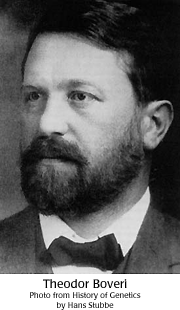Concept 8 Sex cells have one set of chromosomes; body cells have two.

 Theodor Boveri and Walter Sutton both described the process of meiosis. They also showed that although chromosomes may look similar, they have specific hereditary qualities.
Theodor Boveri and Walter Sutton both described the process of meiosis. They also showed that although chromosomes may look similar, they have specific hereditary qualities.
Theodor Boveri (1862-1915)

Theodor Boveri was born in Bamberg, Germany, the son of a doctor. Boveri was artistically inclined. He initially enrolled to study the humanities, but in 1881, Boveri entered the University of Munich to study anatomy and biology. He graduated with his doctorate - summa cum laude - in 1885, with the thesis, Beiträge zur Kenntnis der Nervenfasern (On the Study of Nerve Fibers). He received a scholarship, and was able to continue doing independent research at the zoology department in Munich.
In the late 1880's and early 1890's, Boveri published some of his most significant findings. Oskar Hertwig had already discovered that sperm and egg nuclei fuse during fertilization. Boveri studied the maturation of egg cells of Ascaris megalocephala, the horse nematode. He saw that as egg cells matured, there comes a point where chromosome numbers are reduced in half. Boveri was one of the first to see evidence of the process of meiosis.
Boveri was also one of the first to do experiments in the field of cytology. He chronicled the development of sea urchin eggs, when one egg was fertilized by two sperm. He concluded that male sperm nuclei and female egg nuclei were equivalent in the amount of hereditary information. They each had a half set (haploid number) of chromosomes. As long as there was a set of both (diploid number of chromosomes), there was fairly normal development of the sea urchin larvae. Any more or any less and there was abnormal development. When Mendel's laws were rediscovered in 1900, Boveri recognized the correlation between Mendel's factors and the cytology work being done on chromosomes.
In 1893, Boveri was appointed Professor of Zoology and Comparative Anatomy at the University of Würzburg. In 1902 and 1908, Nettie Stevens spent time in Boveri's lab, and likely was influenced by his cytology work. Boveri was not overly fond of Stevens, and complained about how she was a "bloodsucker," learning much but contributing little.
Boveri remained at the University of Würzburg until his death in 1915.


To prove the fertilizing power of semen (which contain sperm), in 1784, scientists put pants on male frogs before allowing them to mate. It was noted that the resulting eggs never developed.

Why have a reduction system for meiosis? Why not just "destroy" one set of chromosomes to produce sex cells?
 Children resemble their parents.
Children resemble their parents. Genes come in pairs.
Genes come in pairs. Genes don't blend.
Genes don't blend. Some genes are dominant.
Some genes are dominant. Genetic inheritance follows rules.
Genetic inheritance follows rules. Genes are real things.
Genes are real things. All cells arise from pre-existing cells.
All cells arise from pre-existing cells. Sex cells have one set of chromosomes; body cells have two.
Sex cells have one set of chromosomes; body cells have two. Specialized chromosomes determine sex.
Specialized chromosomes determine sex. Chromosomes carry genes.
Chromosomes carry genes. Genes get shuffled when chromosomes exchange pieces.
Genes get shuffled when chromosomes exchange pieces. Evolution begins with the inheritance of gene variations.
Evolution begins with the inheritance of gene variations. Mendelian laws apply to human beings.
Mendelian laws apply to human beings. Mendelian genetics cannot fully explain human health and behavior.
Mendelian genetics cannot fully explain human health and behavior.